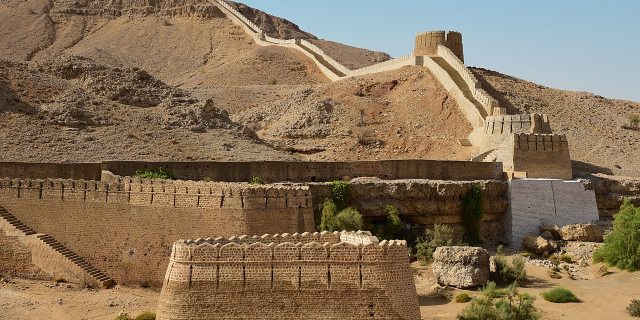Mazar-e-Quaid (Urdu: مزارِ قائد), also known as Jinnah Mausoleum or the National Mausoleum, is the final resting place of Muhammad Ali Jinnah, the founder of Pakistan. Designed in a 1960s modernist style, it was completed in 1971, and is an iconic symbol of Karachi as well as one of the most popular tourist sites in the city. The mausoleum complex also contains the tomb of Jinnah's sister, Māder-e Millat ("Mother of the Nation") Fatima Jinnah, as well as those of Liaquat Ali Khan and Nurul Amin, the first and eighth Prime Ministers of Pakistan respectively. The tomb of Sardar Abdur Rab Nishtar, a stalwart of the Muslim League from Peshawar, is also located there.
Muhammad Ali Jinnah's death occurred in 1948, and his final resting place was marked by a large white marble slab that was raised on a plinth accessed by marble steps.[1] In 1949, the Quaid-e-Azam Memorial Fund (QMF) was established, which received numerous suggestions for the establishment of a memorial to Jinnah.[2] By 1952, his mausoleum was capped by a small dome, with a cabinet that contained some of his personal effects along a wall near his grave.[3] The site had an air of neglect which angered many.[3] Fatima Jinnah and the QMF received numerous letters from concerned Pakistanis at the sad state of his tomb, and advocated for a more befitting monument to Jinnah.[3]
In 1952, the QMF proposed to erect 4 monuments across Pakistan to Jinnah's memory: a mausoleum and mosque on the current site in central Karachi, a Dar-ul-Uloom religions school in Punjab and a University of Science and Technology in East Pakistan.[4] In 1954, an Indian architect was selected to design the mausoleum, but was later dismissed.[2] In 1955, a Turkish architect was hired, but his plan was rejected as well.[2]
In 1957, the Government of Pakistan held an international competition to design a new mausoleum for Jinnah.[5] The competition was initially won by British architect William Whitfield,[6] of the Raglan Squire and Partners firm. The state's efforts to select a design were paralleled by the efforts of the Jinnah's sister, Fatima Jinnah, who sought input from the public in the design of a monument to her brother.[5] Fatima Jinnah effectively vetoed the 1957 proposal, and assumed control of the QMF. She then commissioned architect Yahya Merchant,[7] a Bombay based architect who was a personal friend of Jinnah,[2] to design the monument.
President Ayub Khan laid the foundation stone for the monument on 31 July 1960. It was inaugurated by Yahya Khan on 18 January 1971.[3] The gardens surrounding the mausoleum were not completed until 24 December 2000.[3]































Add new comment